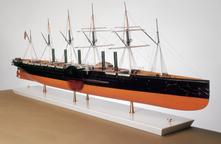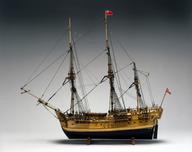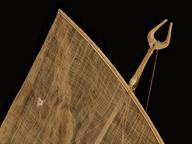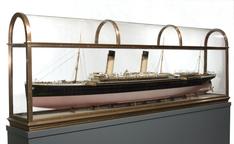

Model of a 5-masted Shantung trading junk
Rigged model of a 5-masted Shantung trading junk, with sails and rigging by George Raleigh Gray Worcester, China, hull unsigned, China, 1931-1933
Junks of this type were formerly built in Shantung Province, they traded to the ports of Yellow Sea and as far south as Shanghai.
The form of the hull was totally different to that of the junks of with Middle or Southern China, for there were without either the keel or stern of the former or the divided stern of the latter.
Their hull was roughly tubular and whale-backed with an added superstructure which greatly resembled that of the 'turret-decked' cargo steamer of 1890-1900. There was no keel, but the central keel-piece was very much thicker that the rest of the planking. Amidships the bottom of the planking was laid longitudinally but in the rising portions both forward and aft, it was laid transversely. In this, just as in the general punt like shape of the hull, there was a great similarity to the junks of the Upper Yangtze. But, as would be expected in a seagoing vessel, there was much greater beam together with a marked taper, to both bow and stern.
The masting was peculiar for in addition to three masts stepped on the midship line, there was two further small masts, one stepped outside the port bow and the other stepped only just inside the port quarter. These unusual positions are said to result from a desire to keep the deck as clear as possible to facilitate the handling of cargo. None of the masts, not even the two heavy primary masts, were stayed in any way; the latter two were each provided with a 'Y' shaped wooden strut which transferred part of the thrust of the sail to the waterways at either side of the super-structure.
The sails, although later made of tanned canvas, preserved the completely rectangular shape of the earlier mat sails. They were closely battened and were controlled by the multiple sheets, as in all Chinese vessels.
The light platform, which projected even further aft than the counter, served both to extend the sheet of the mizen and also to facilitate the working of the stern anchor.
Details
- Category:
- Water Transport
- Object Number:
- 1933-670
- Materials:
- wood (unidentified) and canvas
- Measurements:
-
overall: 1560 mm x 2380 mm x 500 mm, ,
crate: 1910 mm x 2890 mm x 940 mm,
- type:
- model
- credit:
- Shanghai Office of the Inspectorate General of Customs




